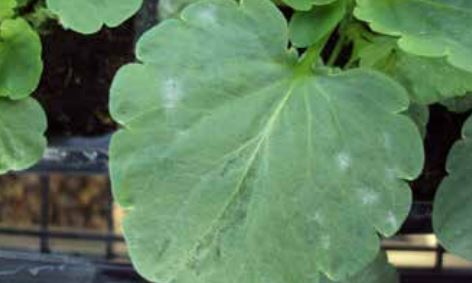Please click here to access the main AHDB website and other sectors.
- Home
- Knowledge library
- Powdery mildew in pansy and viola
Powdery mildew in pansy and viola
Learning how to recognise powdery mildew and understanding its basic biology, will help you choose the best control strategies and minimise the risk of crop damage and fungicide resistance.
This information was last updated in 2014.
Go back to the main page: Controlling leaf and root diseases of pansy and viola
Powdery mildew, caused by Podosphaera violae (formerly Sphaerotheca macularis) is not to be confused with downy mildew especially as the conditions for infection and spread and the control measures for the two organisms are very different.
Powdery mildew fungi are extremely common pathogens and quite host- specific so cross-infection between different bedding plant species is unlikely.
Pansy and viola cultivars differ in their relative susceptibility to powdery mildew, so it is possible to select out and avoid those that are particularly prone.
Powdery mildew symptoms
As a general rule, powdery mildew develops on the upper surface (see Figure 1) of the leaves whereas downy mildew develops on the lower leaf surface.
Occasionally, however, powdery mildew can also be found on the lower surface.
Correct identification is important to ensure the relevant fungicide products are applied.
For confirmation of the disease, plant samples can be submitted to a diagnostic plant clinic.
 Dr G M McPherson
Dr G M McPherson
Figure 1. Early symptoms of powdery mildew on the upper leaf surface of the pansy.
The infection
Infection starts, unlike the downy mildews, on the upper leaf surface as small discrete, faint white patches that consist of numerous thread-like hyphae and spores of the causal fungus Podosphaera violae.
Using a hand lens the hyphae can be seen radiating outwards from a central infection point on the leaf.
These patches increase in size and lesions merge until the entire leaf surface is covered by the white ‘powdery’ fungus.
Disease development, spread and survival
Infection by the pathogen is favoured by warm dry weather although leaf surface moisture is still required initially for spore germination and infection.
Once initiated, infection progresses internally in the leaf tissues irrespective of the external conditions.
The spores are disseminated on air currents to initiate new infections either on the same plant, the same crop or other pansy or viola crops some distance away.
Spore stages
Many powdery mildew fungi have two spore stages in the life cycle and, on some crop species, overwintering spore containing structures may be seen on old powdery mildew lesions.
These structures can tolerate extremes of temperature and moisture levels so can survive periods when crops are not present.
When mature, these structures release spores into the air which can travel long distances to infect crops.
Controlling downy mildew
Cultural control measures are very important, but in this case the pathogen prefers warm drier conditions for epidemic development so it is more likely to be a problem during the summer and early autumn period.
As some powdery mildews also have weed hosts it is advisable to actively maintain an effective weed control programme in and around the nursery.
The range of effective plant protection products that are available for powdery mildew control is very different to that for downy mildew control but, for similar reasons, it is important to devise an alternating spray programme and avoid reliance on a single product for long-term control.
Biofungicide products are available and should, where possible and practicable, be included.
Useful links
Download the original PDF version of this information from 2014
Read about bacterial diseases of protected ornamentals and possible control measures
Authors
Original authored by Andrew Jackson, Martin McPherson, and Wayne Brough.
Topics:
Sectors:
Tags:

